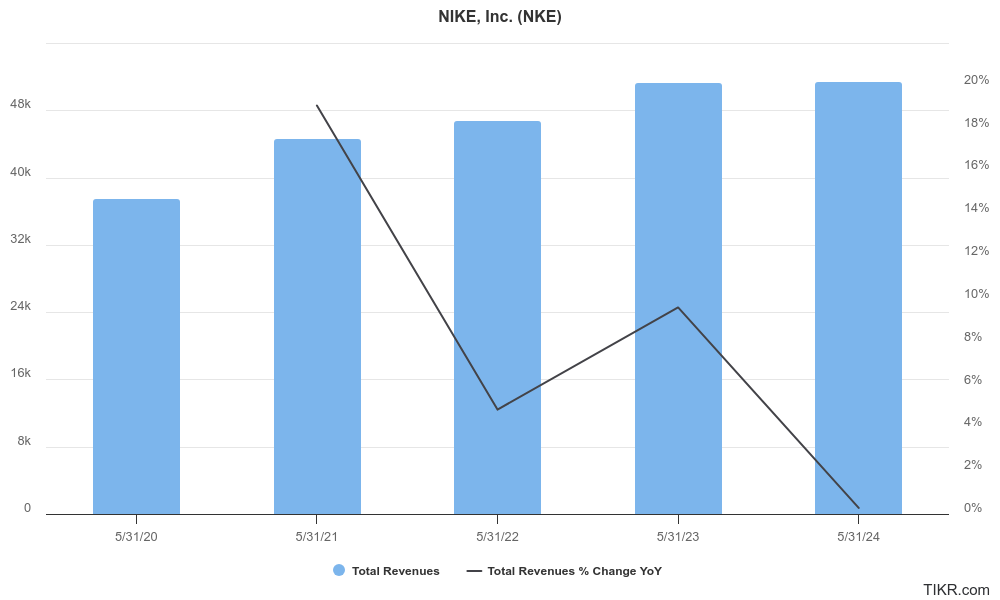Bill Ackman Upped His Nike Stake in Q3 as Stock Plummeted
Please note that we are not authorised to provide any investment advice. The content on this page is for information purposes only.
Bill Ackman’s Pershing Square upped its stake in Nike (NYSE: NKE) in Q3 as the stock plummeted. Ackman started building a stake in the sneaker giant in Q2 and raised his stake to over $1.4 billion at the end of September.
Notably, Nike is among the bottom 20 S&P 500 stocks this year as the company grapples with slowing sales. It even replaced its CEO and brought back Elliott Hill as the CEO who replaced John Donahoe.
Hill worked at Nike for 32 years before retiring in 2020. Donahoe took over as the CEO in January 2020 and led the company during the COVID-19 pandemic. While Nike stock rose to an all-time high in late 2021 under his watch, it subsequently fell below the price levels when he took over.
Nike Is Revamping Its Strategy
Notably, Donahoe revamped Nike’s sales and distribution strategy to focus on the Direct channel – which includes both its stores and online sales through its website. In the process, the company cut down on wholesalers which are an important distribution channel.
The strategy paid off well during the COVID-19 pandemic when many people pivoted to ecommerce and Nike’s online sales soared. However, by cutting back on wholesalers, Nike opened the gate for competition to occupy its shelf space. While direct sales are invariably high margin as compared to channel sales, the strategy backfired as people returned to stores – many of which did not either have Nike products or had limited stock.
Nike reported revenues of $11.59 billion in the fiscal first quarter which were 10% lower YoY and below the $11.65 billion that analysts were modeling. The company’s per-share earnings came in at 70 cents which was ahead of the 52 cents that analysts were expecting.
Nike Missed Revenue Estimates
Nike’s guidance for the current quarter was also below Street estimates. The company forecast sales to fall by between 8%-10% in the current quarter which is worse than the 6.9% fall that analysts were expecting.
Notably, while Nike’s bottomline performance has been relatively strong, its topline growth has disappointed and it missed revenue estimates in three of the four quarters in the last fiscal year.
Nike Withdrew Its Annual Guidance
Nike withdrew its annual guidance and intends to provide quarterly guidance on every earnings call during this fiscal year. “This provides Elliot with the flexibility to reconnect with our employees and teams, evaluate the current strategies and business trends, and develop our plans to best position the business for fiscal ’26 and beyond,” finance chief Matthew Friend said on an earnings call with analysts,” said Nike’s CEO Matthew Friend on the decision.
Analysts on NKE Stock
CFRA analyst Zachary Warring said that it would take a few quarters before Nike’s efforts to revive its sagging sales start to show “real results.” Nike expects its margins to stay flat and sales to fall which he said is not a “good sign for any company.” While Zacharry was supportive of Hill’s return as the CEO and termed him a “great pick” he warned that the company faces “larger issues. According to Zacharry, Nike is looking for its “next leg of growth” but stressed that “we don’t know where’s that’s going to come from.”
Zachary does see the stimulus in China as a tailwind for Nike but pointed to the several new rivals in the industry while adding “We will sit and wait.”
Notably, Nike gets around a sixth of its revenues from Greater China and the country has also been its manufacturing hub. It has however not been immune to the slowdown in the world’s second-biggest economy.
Nike Reported a Fall in Its Greater China Revenues
Nike reported a 4% YoY fall in its revenues in the Greater China region in the fiscal Q1. While the revenue decline was below the 10% overall fall that the company saw and Greater China was the second-best performing region behind just Asia Pacific and Latin America, the company was not satisfied with its performance in the region.
During the Q1 earnings call, CFO Matthew Friend said, “We saw particular softness in traffic on NIKE Digital as well as in our partner stores in Greater China. As a result, retail sales underperformed our plan, including our wholesale partners, with slightly elevating marketplace inventories requiring higher levels of promotional activity in Q1 to drive conversion.”
China has announced a flurry of stimulus measures to support its economy but a section of the market believes that the world’s second-biggest economy needs to do a lot more to address the structural and deep slowdown – especially in the real estate sector.
Trump’s Return to the White House Could be a Risk for NKE
In his first tenure, Trump imposed a 25% tariff on most imports from China, and Nike and Apple were among the US companies that fell the heat from the trade war in his tenure. Trump has vowed to increase tariffs on imports from China even further.
There are fears that US brands, many of which are anyways battling slowing sales in China amid tepid economic growth and the move towards domestic brands, could see their fortunes dip further in the country.
According to Michael Hart, president of the American Chamber of Commerce in China, “The worst part is the consumer brands that are not of a strategic nature and themselves are not controversial and would not be subject to export restrictions might be punished by the local consumer because of their nationality.”
Hart added, “Since Covid, companies have been looking to diversify and bolster their supply chains, but there are still no easy and reliable replacements for the supply chains and manufacturing that has developed in China over the past decades.”






